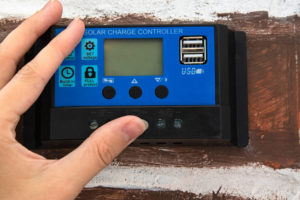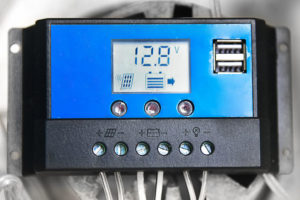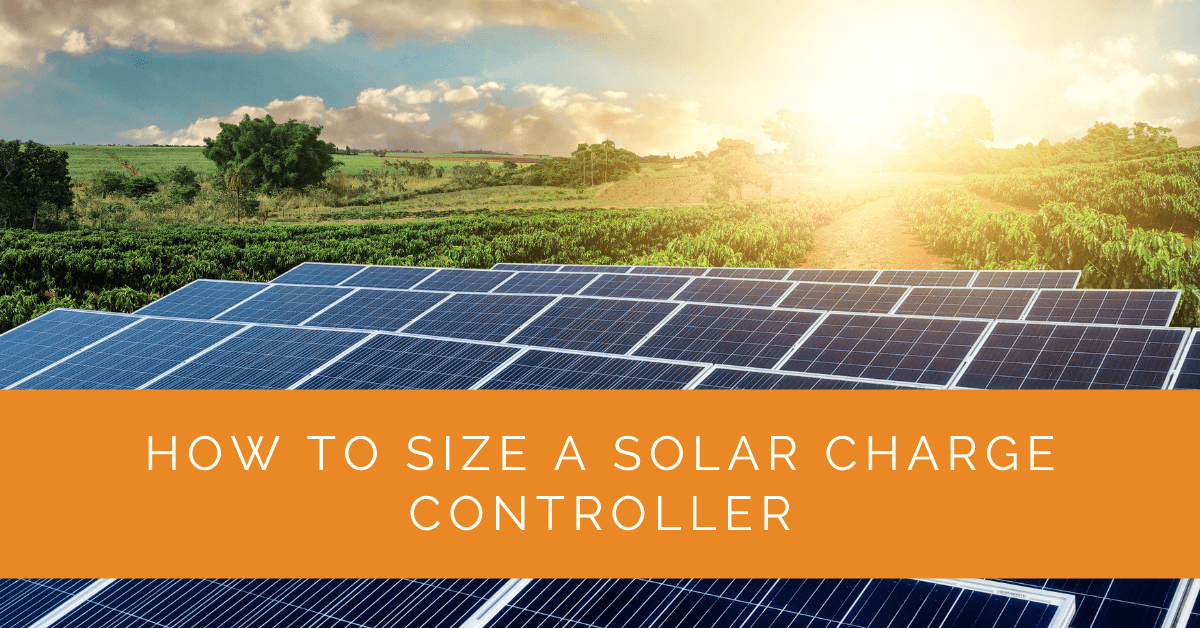In any solar power system, a solar charge controller plays a crucial role in regulating and protecting batteries. Understanding how to size a solar charge controller properly is essential for optimizing system performance and ensuring the longevity of your batteries. This article will guide you through sizing a solar charge controller, considering factors such as solar panel array current, battery bank capacity, charge controller types (PWM and MPPT), and other considerations. Let’s dive in and learn how to size a solar charge controller for your solar power system.
Contents
- 1 Key Takeaways
- 2 Understanding Solar Charge Controllers
- 3 Assessing Your Solar Power System
- 4 Determining Charge Controller Capacity
- 5 Choosing the Right Charge Controller Type
- 6 Factors Affecting Sizing Decisions
- 7 Installation and Wiring Guidelines
- 8 Monitoring and Maintenance of Charge Controllers
- 9 Case Study: Optimizing Solar Power Systems with Properly Sized Charge Controllers
- 10 Expert Insights From Our Solar Panel Installers About How to Size a Solar Charge Controller
- 11 Experience Solar Excellence with Us!
- 12 Conclusion
Key Takeaways
- A solar charge controller is crucial for regulating and protecting batteries in a solar power system, and sizing it properly is essential for system optimization and battery longevity.
- There are two main types of solar charge controllers: PWM (Pulse Width Modulation) and MPPT (Maximum Power Point Tracking). MPPT controllers are more efficient and suitable for larger systems with higher currents and voltage differences between panels and batteries.
- Factors like solar panel array current, battery bank capacity, voltage, environmental conditions, and installation guidelines should be considered when sizing and maintaining a solar charge controller for optimal performance.
Understanding Solar Charge Controllers
A solar charge controller intermediates the solar panel array and the battery bank. It manages the charging process, preventing overcharging and over-discharging of the batteries. There are two main types of solar charge controllers: Pulse Width Modulation (PWM) and Maximum Power Point Tracking (MPPT). Understanding the characteristics and differences between these types is essential for proper sizing.
PWM Charge Controllers
PWM charge controllers regulate the charging process by modulating the width of the charging pulses. They are suitable for smaller systems with lower solar panel array currents. PWM controllers are cost-effective and straightforward, making them popular for off-grid solar systems. However, they are less efficient than MPPT controllers, especially when the solar panel array voltage is significantly higher than the battery bank voltage.
MPPT Charge Controllers
MPPT charge controllers, on the other hand, utilize advanced electronics to track the maximum power point of the solar panel array. They convert the excess voltage into additional current, maximizing the power output. MPPT controllers are highly efficient and can handle higher solar panel array currents and voltage differences between the solar array and the battery bank. They are particularly advantageous in larger and more complex solar power systems, as they can significantly increase energy harvest.
Assessing Your Solar Power System
Before sizing a solar charge controller, assessing your solar power system components, including solar panels, batteries, and loads, is important. The following steps will help you gather the necessary information:
- Solar Panel Array Current: Determine the total current generated by your solar panel array. This can be calculated by summing up the individual panel currents or checking the specifications provided by the manufacturer.
- Battery Bank Capacity: Assess the capacity of your battery bank, typically measured in amp-hours (Ah) or watt-hours (Wh). This information is crucial for understanding the charging requirements and selecting an appropriate charge controller.
- System Voltage: Determine the voltage rating of your solar power system. Common off-grid systems operate at 12V, 24V, or 48V, depending on the battery bank configuration and loads.
Determining Charge Controller Capacity
Once you have gathered the information about your solar power system, you can determine the appropriate capacity for your charge controller. The general rule of thumb is to choose a charge controller that can handle the maximum current generated by your solar panel array.
For PWM charge controllers, select a controller with a current rating equal to or slightly higher than the total solar panel array current. However, for MPPT charge controllers, you have more flexibility as they can handle higher currents and voltage differences. In MPPT controllers, the charging current is typically limited by the battery bank capacity rather than the solar panel array current.
Considerations for Future Expansion: If you anticipate expanding your solar panel array, it is advisable to choose a charge controller with some headroom. Selecting a slightly larger controller can accommodate future growth without upgrading the charge controller.

Choosing the Right Charge Controller Type
The choice between PWM and MPPT charge controllers depends on various factors such as system size, voltage differences, and budget. Here’s a closer look at the advantages and limitations of each type:
PWM Charge Controllers
Advantages:
- Cost-effective solution for smaller off-grid systems.
- Simple and easy to use, with straightforward installation.
- Suitable for systems with lower solar panel array currents.
- Can work well when the solar panel array voltage is close to the battery bank voltage.
Limitations:
- Less efficient compared to MPPT controllers, especially in scenarios with higher solar panel array voltages.
- Limited capability to handle larger solar panel array currents.
- Not ideal for systems with a significant voltage difference between the solar array and the battery bank.
MPPT Charge Controllers
Advantages:
- Highly efficient, especially in higher solar panel array voltages and current scenarios.
- Can handle larger solar panel array currents, making them suitable for larger systems.
- Maximizes energy harvest by converting excess voltage into the additional current.
- Allows for flexibility in system design, accommodating various voltage differences between the solar array and battery bank.
Limitations:
- Higher cost compared to PWM controllers.
- More complex electronics and installation compared to PWM controllers.
- Overkill for smaller systems with lower solar panel array currents and voltage similarities.
Consider your solar power system’s specific needs and requirements to determine the most suitable charge controller type.
Factors Affecting Sizing Decisions
Several factors can influence the sizing decisions for your solar charge controller. These include:
Environmental Factors
- Temperature: High temperatures can affect the performance and efficiency of charge controllers. Consider the temperature range in your location and choose a charge controller with a temperature rating suitable for your climate.
- Solar Irradiance: The sunlight your location receives throughout the year affects the solar panel array current. Consider the seasonal variations in solar irradiance and select a charge controller capable of handling the maximum expected current.
Battery Chemistry and Voltage Requirements
Different battery chemistries have different voltage requirements and charging characteristics. Ensure that the charge controller you select is compatible with your specific battery chemistry. Additionally, verify that the charge controller’s voltage rating matches the voltage of your battery bank.
Charge Controller Efficiency and Derating
Consider the efficiency rating of the charge controller, as it directly affects the overall performance of your solar power system. Higher efficiency controllers convert more solar energy into usable power, maximizing the energy harvest. Additionally, consider derating factors affecting the charge controller’s maximum capacity in real-world conditions, such as high temperatures or suboptimal installation configurations.

Installation and Wiring Guidelines
Proper installation and wiring are crucial for your solar charge controller’s efficient and safe operation. Here are some guidelines to follow:
- Read the Manufacturer’s Instructions: Carefully read and understand the installation instructions provided by the charge controller manufacturer. Follow the recommended guidelines to ensure a proper and compliant installation.
- Wire Sizing: Use appropriate wire sizes for connecting the solar panels, charge controller, battery bank, and loads. Refer to wire sizing charts or consult a professional electrician to determine the correct wire gauge based on the maximum current and length of the wire runs.
- Fusing and Protection: Install appropriate fuses or circuit breakers to protect the charge controller, battery bank, and wiring. Fuses or breakers help prevent damage from excessive currents and ensure the safety of your system.
- Proper Grounding: Follow grounding guidelines to ensure proper electrical safety. Ground the charge controller and other system components according to local electrical codes and regulations.
- Positioning and Ventilation: Install the charge controller in a well-ventilated area to dissipate heat effectively. Avoid mounting it in direct sunlight or near heat-emitting components to prevent overheating.
Monitoring and Maintenance of Charge Controllers
Regular monitoring and maintenance are essential to ensure your solar charge controller’s smooth operation and longevity. Here are some important aspects to consider:
- Performance Monitoring: Regularly monitor the performance of your charge controller. Check the charging status, battery voltage, and system parameters to ensure proper operation. Utilize the monitoring features provided by the charge controller or install a separate monitoring system to track performance.
- Battery Voltage Calibration: Some charge controllers may require periodic voltage calibration to ensure accurate battery voltage readings. Follow the manufacturer’s instructions for calibration procedures and perform them as recommended.
- Cleaning and Inspection: Clean the charge controller periodically to remove dust, dirt, or debris hindering its performance. Inspect the terminals, wiring connections, and ventilation ports for any signs of corrosion or damage. Clean or replace any components as necessary.
- Software and Firmware Updates: Stay updated with the latest versions if your charge controller has software or firmware capabilities. Check the manufacturer’s website or contact their support for any available updates that may improve performance or add new features.
- Battery Maintenance: Properly maintain your batteries to ensure their longevity and performance. Follow the manufacturer’s guidelines for battery maintenance, including regular equalization, cleaning, and monitoring of electrolyte levels (for flooded lead-acid batteries).
By implementing regular monitoring and maintenance practices, you can detect and address any issues promptly, ensuring your solar charge controller’s efficient and reliable operation.
Case Study: Optimizing Solar Power Systems with Properly Sized Charge Controllers
Background
A residential client approached Solar Panels Network USA to optimize their existing solar power system. They were experiencing inefficiencies and wanted to ensure their system was equipped with the right charge controller to maximize performance and protect their batteries.
Project Overview
We conducted an in-depth assessment of the client’s solar power system, focusing on their solar panel array, battery bank, and overall energy needs. The goal was to determine the appropriate type and size of the solar charge controller to improve system efficiency and longevity.
Implementation
- System Assessment: We started by evaluating the total current generated by the client’s solar panel array and the capacity of their battery bank. This information was crucial for selecting the right charge controller.
- Choosing the Charge Controller Type: Based on the system size and voltage differences between the solar panels and battery bank, we recommended an MPPT charge controller. This type of controller was ideal due to its higher efficiency and ability to handle larger currents.
- Sizing the Charge Controller: We calculated the required capacity by considering the maximum current output of the solar panel array. We selected an MPPT charge controller that could handle the peak current with additional capacity for future expansion.
- Installation and Wiring: Our team installed the MPPT charge controller, ensuring proper wiring and connections according to the manufacturer’s guidelines. We also upgraded the wiring and breaker box to accommodate the new controller and prevent any potential overloading issues.
Results
- Improved Efficiency: The new MPPT charge controller significantly improved the energy conversion efficiency of the solar power system. The client noticed a marked increase in the energy harvested, especially during peak sunlight hours.
- Battery Protection: The charge controller effectively regulated the charging process, preventing overcharging and over-discharging of the batteries. This protection extended the battery life and maintained their optimal performance.
- Future Expandability: The charge controller was selected with additional capacity, allowing the client to add more solar panels in the future without needing an immediate upgrade. This flexibility provided peace of mind and scalability.
- Enhanced Monitoring: The MPPT charge controller included advanced monitoring capabilities, allowing the client to track system performance, monitor battery status, and optimize energy usage.
Summary
This case study highlights the importance of properly sizing a solar charge controller to optimize system performance and protect the battery bank. By selecting an MPPT charge controller tailored to the client’s solar panel array and battery capacity, Solar Panels Network USA enhanced the efficiency and reliability of the client’s solar power system. The new charge controller not only improved energy harvest but also provided flexibility for future expansion, ensuring the long-term success of the solar installation. Proper installation and adherence to best practices were crucial in achieving these results, demonstrating the value of professional expertise in solar power solutions.
Expert Insights From Our Solar Panel Installers About How to Size a Solar Charge Controller
Properly sizing your solar charge controller is essential for protecting your batteries and ensuring optimal system performance. It’s important to understand your solar panel array current and battery capacity before selecting a charge controller.
Senior Solar Technician
Choosing between PWM and MPPT charge controllers depends on your system size and budget. MPPT controllers, although more expensive, can significantly increase energy harvest by efficiently converting excess voltage into additional current.
Lead Solar Installer
Don’t forget to consider future expansion when sizing your charge controller. Selecting a controller with some headroom allows for the addition of more panels without the need for immediate upgrades.
Solar Energy Consultant
Experience Solar Excellence with Us!
Trust in Solar Panels Network USA, where our seasoned experts deliver top-quality solar solutions for homes and businesses nationwide. With a legacy of countless successful installations and a commitment to sustainable energy, we’re your reliable partner in the solar journey. Ready for a brighter, eco-friendly future? Call us now at (855) 427-0058 and harness the power of the sun!
Conclusion
Sizing a solar charge controller is crucial in designing a solar power system. You can select the appropriate charge controller type and capacity by understanding the solar panel array current, battery bank capacity, and various other factors. Whether you choose a PWM or MPPT charge controller, ensure it meets the voltage requirements and can handle the maximum current of your system.
Proper installation, wiring, and adherence to manufacturer guidelines are essential for the safe and efficient operation of the charge controller. Regular monitoring, maintenance, and performance optimization will help maximize energy harvest, protect your batteries, and ensure the longevity of your solar power system.
When sizing a solar charge controller, consider your solar power system’s specific needs and requirements. By making informed decisions and following best practices, you can optimize the performance and reliability of your solar charge controller, ultimately enhancing your solar power system’s overall efficiency and effectiveness.
If you have any doubts or require further assistance, consult with a solar power professional or contact the manufacturer for specific recommendations based on your system specifications.
About the Author
Solar Panels Network USA stands at the forefront of solar energy solutions, driven by a team of seasoned solar engineers and energy consultants. With over decades of experience in delivering high-quality solar installations and maintenance, we are committed to promoting sustainable energy through customer-centric, tailored solutions. Our articles reflect this commitment, crafted collaboratively by experts to provide accurate, up-to-date insights into solar technology, ensuring our readers are well-informed and empowered in their solar energy decisions.

